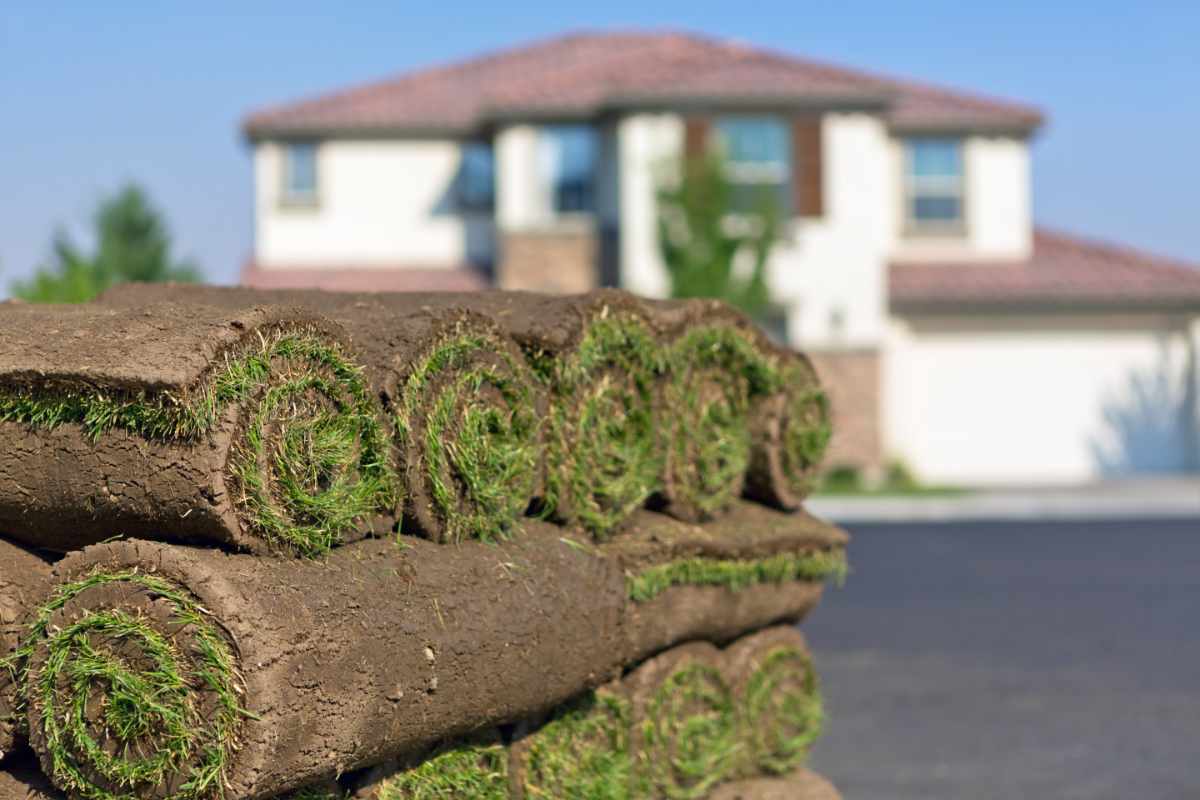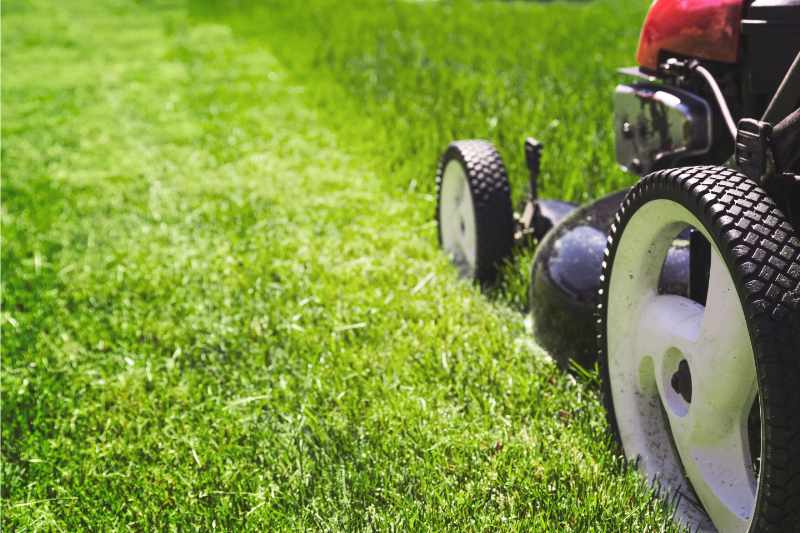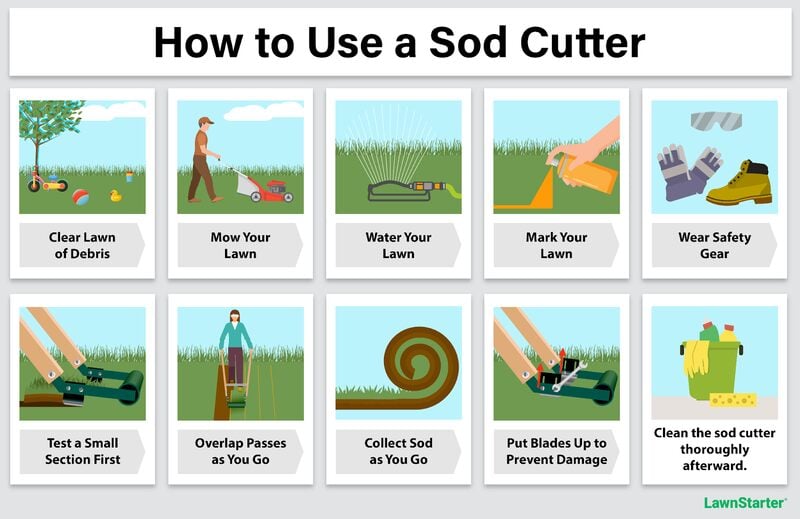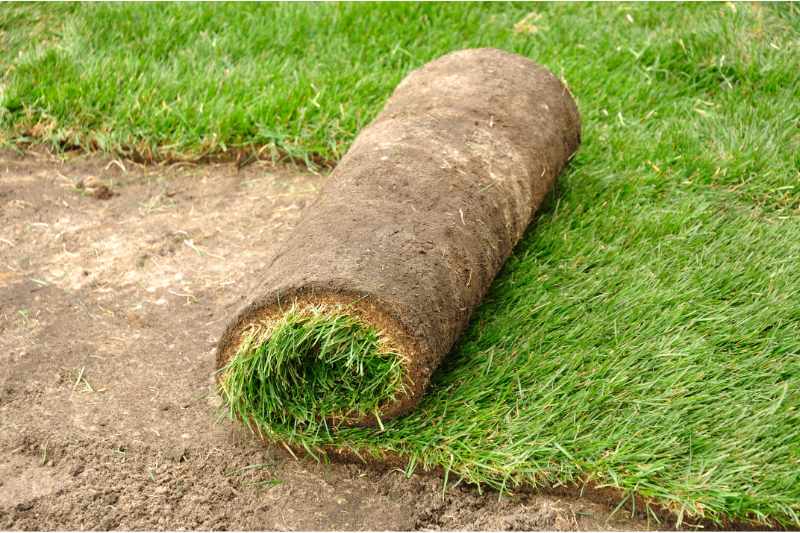
Are you starting your lawn over from scratch? Before you lay down sod, plant grass seeds, or hydroseed, you need to clear out your existing live grass. Using a sod cutter is one of the many ways to remove lawn grass. But, if you’re like most homeowners, you’ve probably never had an occasion to use this particular power tool, and you likely don’t know how to use a sod cutter.
How to use a sod cutter depends greatly on the type of sod cutter you’ll be using. But don’t worry – we’ll teach you how to use the four types of sod cutters and tell you when each type is most appropriate to use.
- Tools and Materials Needed
- General Tips to Follow When Cutting Sod
- For General Use: How to Use a Motorized Sod Cutter
- For Gas-less Cutting: How to Use a Manual Kick-Plow Sod Cutter
- For Small Areas: How to Use a Square-Edge Sod Cutter
- For Large Areas: How to Use a Tractor-Mounted Sod Cutter
- Sod Cutter Basics
- FAQ About Using a Sod Cutter
Tools and Materials Needed
You don’t need much to clear out your lawn with a sod cutter. However, you should prepare these tools to make it easier for you:
- Sod cutter
- Lawn mower
- Rake
- Tape measure
- Lawn-friendly, water-based paint, like chalk spray
- Protective equipment
- Safety glasses
- Gloves
- Close-toed shoes
There’s some prep work involved before you actually get down and dirty with the sod cutter, which is what some of the tools are for. Up next are some tips you should follow no matter what sod-cutting tool you use.
General Tips to Follow When Cutting Sod

There are some things you should keep in mind before, during, and after cutting sod, no matter what type of sod cutter you have at your disposal.
Before: Clear Lawn of Debris
Remove any tools, toys, large rocks, and other debris from your lawn. You can use a rake to make it easier. This will not only make it easier to use your sod cutter but also prevent any damage to your sod-cutting tool.
Before: Mow Your Lawn
Set your lawn mower to the lowest setting and mow your lawn a few days before cutting sod. This will make it easier for the sod cutter to do its job.
Before: Water Your Lawn
Get your irrigation system or hose running! You should water your lawn a few days before cutting sod so the soil is moist but not soaking wet. It’s easier to use a sod cutter on moist soil than on dry soil.
Before: Mark Your Lawn
Measure out and mark the area where you’ll be removing sod using a tape measure and a lawn-friendly, water-based paint. Chalk spray is a good choice. This will make it easier for you to know where to stop using your sod cutter.
Mark any sprinkler heads you have at this stage, too. You don’t want to hit them, which can damage both the sprinklers and your sod cutter.
Take this time to call 811 to reach a utility marking service, too. They’ll let you know where buried utilities are located on your property and mark them so you don’t accidentally dig into them.
Before: Wear Safety Gear
It’s always recommended to wear safety gear when cutting sod, as it can take a while to remove large areas of sod from your lawn. Some sod cutters can also kick up small rocks, so it’s smart to keep your eyes protected.
Before: Test a Small Section First
Make sure everything is in working order by cutting out a small section of sod. Check if the depth is correct and if the sod cutter’s blade is level with the ground. If everything looks right, then you’re ready to cut the rest of your sod.
During: Overlap Passes as You Go
Overlapping your rows as you cut sod means there’s less chance of leaving behind strips of living grass.
During: Collect Sod as You Go
You can roll the sod strips up or cut them up into smaller, more manageable sections — about 3 to 5 feet long. Collect them in a wheelbarrow as you work so you can clearly see which parts of your lawn you’ve already cut out.
After: Put Blades Up to Prevent Damage
When you’re done and need to move the sod cutter off of your lawn to clean it, put its blades up to prevent them from scraping against rocks and hardscaping that can damage them.
Clean the sod cutter thoroughly afterward.
For General Use: How to Use a Motorized Sod Cutter
Also known as self-propelled walk-behind sod cutters, motorized sod cutters are the most popular type of sod cutter among homeowners that need to remove large areas of sod. These gas-powered tools are very powerful and don’t require as much manual labor as other types of sod cutters. However, they can be difficult to use because they tend to shake a lot.
Here are some general steps on how to use a motorized sod cutter. However, each model has slight differences, so it’s best to read your sod cutter’s manual for specifics.
Step 1
Check your sod cutter over. Check its oil level and add more if needed. Check its gas level, too; add gas as needed.
Step 2
Put the sod cutter’s gear shift in neutral and raise the blade. Then, push the motorized sod cutter to the edge of the area you’ll be cutting sod from.
Step 3
Lower the sod cutter’s blade and start the engine. You’re ready to start cutting sod.
Step 4
Shift to low gear, then pull back on the throttle gently. Push the cutter forward a few feet and shift it back into neutral. Check how deep the blade has cut and adjust it if necessary.
Step 5
Shift the gear back to low and continue cutting sod until you reach the end of the area you want to cut sod from. Raise the handles of the sod cutter to push the blade down, which will sever the sod strip from your lawn. Roll up the strip of sod or cut it into smaller pieces and remove it from the lawn before continuing to the next row.
Step 6
Shift the gear into neutral and move the sod cutter to the start of the next row. Continue cutting after shifting to low gear. Rinse and repeat until you finish cutting all the sod you need to remove.
Step 7
Shift your sod cutter to neutral and turn it off once you’re done.
For Gas-less Cutting: How to Use a Manual Kick-Plow Sod Cutter
In contrast to a motorized sod cutter, a manual kick-plow sod cutter isn’t powered by gas. All you need to make it run is patience and a little elbow grease. Also called a kick sod cutter, this tool looks like something you would find on a farm. It has two long handles connected by a knee-height crossbar, a roller, and a flat blade that’s supposed to be flush with the ground.
A manual sod cutter works by kicking the crossbar, which moves the frame forward and into the ground. Because of how labor-intensive it is, it’s best for small-scale sod removal. Here’s how to use a kick sod cutter:

Step 1
Bring your kick sod cutter to the outermost edge of the area you plan to remove sod from. Hold the handles and kick the crossbar with the sole of your boot to make the first cut (you’ll want a sturdy work boot for this task – we don’t recommend regular sneakers).
Step 2
Continue kicking the crossbar until you reach the other end of the area you marked out to cut the sod.
Step 3
Raise the handles of the kick sod cutter to separate the sod strip from the rest of your lawn. Roll up the strip or cut it into smaller pieces for removal. Rinse and repeat until you’re done.
For Small Areas: How to Use a Square-Edge Sod Cutter

A square-edge sod cutter — also known as a landscaper spade — is the simplest and most affordable sod cutter. It’s a shovel with a shorter handle and a squared edge. Aside from grass removal, you can also use this tool to edge your garden.
When taking cost and effort into account, a square-edge sod cutter is probably the best option if you only need to remove very small sections of sod (less than 500 square feet). You can also use this as an edger. Here are the steps to use a square-edge sod cutter:
Step 1
Start at the edge of the space where you’re removing sod. Align the sod cutter’s edge perpendicular to the ground and push it down about 1 ½ to 3 inches deep into the grass. Go around the edge of the area you plan to cut sod from and repeat the process until you’ve gotten back to where you started.
Step 2
Starting at the edge you just created, set the sod cutter at an angle and push it down with your boot. Keep pushing horizontally in a straight line, creating a strip of sod as you go. Listen for a slicing sound; that means the grass roots are being cut through. Keep going until you reach the opposite edge of the area.
Step 3
Once you’ve reached the other end of the marked area, lift away the strip of sod, flip it over, and roll it up. Rinse and repeat until you’ve removed all of the sod you want cut.
Pro Tip: Cut small, manageable chunks of sod at a time — about 3 feet long — to make cleanup and removal easier.
For Large Areas: How to Use a Tractor-Mounted Sod Cutter
In contrast to a square-edge sod cutter, tractor-mounted sod cutters are very expensive. Homeowners planning to use one of these need to rent a tractor and the sod cutter itself.
However, it’s the most effective way to remove lots of sod from a very large area if you think it’s worth the price. Because they’re so large and expensive, tractor-mounted sod cutters aren’t often used for residential projects.
But, if you’re the rare homeowner who needs a sod cutter this big, and you’re willing to pay the price, here’s how to use a tractor-mounted sod cutter:
Step 1
Slide the mount onto the tractor’s hitch arms and set the tractor’s weight transfer to zero. Set the sod cutter’s cutting depth to 1 ½ to 3 inches.
Step 2
Using the tractor’s lever, press down on the hitch arms to lower the sod cutter blade until it’s flush with the ground. Then, drive the tractor forwards. The cutting blade should settle under your grass.
Step 3
Drive the tractor across your lawn. After reaching the edge of the area you want to cut sod from, lift the tractor’s hitch arms to raise the cutting blade out of the soil. Rinse and repeat until you’ve covered the entire area where you want to remove grass, turning at each corner as if you were mowing your lawn.
Sod Cutter Basics
A sod cutter is a useful tool for removing grass. While they can be manual or motorized, all sod cutters work the same way: They slice horizontally through the soil, cutting grass at the roots. The grass is divided into strips that can be replanted, mulched, or composted.
Pros and Cons of Cutting Sod
Using a sod cutter has its advantages and disadvantages. Let’s take a look at them in this table:
| Pros | Cons |
| ✔ Quickest method of removing sod ✔ Straightforward ✔ Herbicide-free ✔ Sod strips can be replanted, mulched, or composted ✔ Can be cheap depending on the tool | ✘ Not as effective for deep-rooted grasses (i.e. Bermuda) and weeds (i.e. nutsedge) ✘ Can hurt shrub and tree roots ✘ Can be labor-intensive ✘ Motorized sod cutters need gas and produce harmful emissions |
FAQ About Using a Sod Cutter
It’s recommended that you use a self-propelled sod cutter for a clean, even cut on slopes. You will find it easier to cut sod on slopes by going from top to bottom rather than trying to push the machine uphill.
You should consider cutting sod when your lawn is made up mostly of weeds. It might be easier to grow a new lawn than maintain your current one.
If you are removing your grass because you want to plant new grass seeds, hydroseed, or lay down new sod, you should cut sod anytime between spring to fall so that you can grow your new lawn immediately after.
Learn more about when to start a new lawn with our article about the best time to plant grass seeds.
Improperly cut sod can leave the soil at the wrong height, which will cause any new sod or grass you plant to be off-level with your existing turf.
It depends on several factors, but mostly the scale of the sod removal project. For smaller projects, something like the Fiskars Square Garden Spade Shovel is a good choice. Larger projects will benefit from a motorized sod cutter like the Classen PRO Hydro-Drive Sod Cutter. You can find out more in our best sod cutters product review.
While sod can last up to 2 days after being cut, it’s wise to lay down your cut sod within the day. You only need to worry about this if you plan to replant it.
If you plan to add a new landscaping feature to your lawn — like a flower bed or hardscaping — or if you want to plant something else, it might be better to remove your turf for a clean slate.
Do you mind waiting for a longer period of time for your sod to die off? If not, you can try these other methods of removing lawn grass:
• Herbicide
• Tiller
• Solarization
• Sheet mulching
Cutting Sod DIY vs Professional Sod Cutting Services
While you can save money on labor if you remove your lawn DIY, there are a few benefits to hiring a lawn care professional to do it instead. Getting a pro to do it means you don’t have to rent (or buy!) equipment and learn how to use it. Plus, experienced pros will produce better results than you could on your first time using a sod cutter.
So, why not sit back, relax, and hire a lawn care company to do the backbreaking work for you? Connect with capable lawn care pros in your area today.
Photo Credit: MariuszBlach / Canva Pro / License